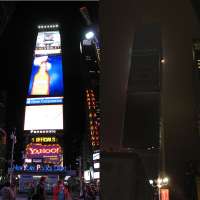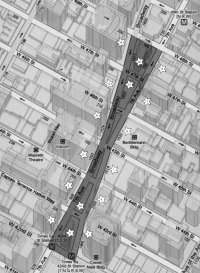A Starry Minute proposes to collaborate with building owners in Times Square to turn off all of the commercial signage in the area (41 St. - 50 St. between Broadway and 7th Ave) simultaneously for one minute. A Starry Minute’s specific duration of 60 seconds starts when the signs are turned off, and ends when the signs are turned back on.
A Starry Minute is a time based participatory- and site sensitive public art intervention using darkened signs at Times Square. As one of the brightest site on Earth during the night, Times Square is an apt location for the project. The ideal timing for it to happen is during the New Moon when the sky is as dark as possible, sometime between dusk and midnight. The Atomic Clock will be used to adjust synchronization. To document A Starry Minute on video with the help of satellites is a goal of the artist.
”When we design space, we inevitably design peoples behavior in that space.” Vito Acconci in conversation with Hans Ulrich Obrist, e-flux Space, 2009, May 12
A Starry Minute will not only affect the light situation at Times Square but also the sense of speed of the site and atmosphere. The random rhythm and constant movement of the signs that covers the architecture will during the 60 seconds stop and strengthen the experience of another landscape that is in contrast to what we usually expect to experience in Times Square. 60 seconds later it will transform again back to the electric hyper urban landscape.
“As I gaze upon over-lit lobbies and malls, I sense that what was being lit was not the space but merely a fear (legal or otherwise) of the consequence of darkness. How do we address this fear? Instead of prescribing light quantities and design strategies, let us first consider the innate beauty and essence of darkness.” Edward Bartholomew, light designer.
People from an older generation that experienced Times Square will always remember the Clicquot Club Ginger Ale sign from the beginning of the 20th century, which emphasized the loss of the night sky and its phenomena by including the image of Aurora Borealis as part of the design of the sign. Kathleen Hulser, a Public Historian from the New-York Historical Society comments on this particular sign, that it is a “close-up of this substitute sky that is doing its little stage drama”. A Starry Minute is a project that can be viewed in this tradition of using signage in Times Square to create a contemporary narrative, which in this case contains the relationship between issues such as time, scale, urban development, public art, architecture, cultural geography and participatory practices.
”Darkness is to space what silence is to sound, i.e., the interval” Marshall McLuhan, Through the Vanishing Point: Space in Poetry and Painting.
Katja Aglert initiated A Starry Minute in 2007 and was with the support of Lower Manhattan Cultural Council (LMCC); Moderna Museet in Sweden; and International Artist’s Studio Program in Sweden (IASPIS), able to work with the project on site in New York during 2008 and 2009. A Starry Minute was never realized.
A Starry Minute proposes to collaborate with building owners in Times Square to turn off all of the commercial signage in the area (41 St. - 50 St. between Broadway and 7th Ave) simultaneously for one minute. A Starry Minute’s specific duration of 60 seconds starts when the signs are turned off, and ends when the signs are turned back on.
A Starry Minute is a time based participatory- and site sensitive public art intervention using darkened signs at Times Square. As one of the brightest site on Earth during the night, Times Square is an apt location for the project. The ideal timing for it to happen is during the New Moon when the sky is as dark as possible, sometime between dusk and midnight. The Atomic Clock will be used to adjust synchronization. To document A Starry Minute on video with the help of satellites is a goal of the artist.
”When we design space, we inevitably design peoples behavior in that space.” Vito Acconci in conversation with Hans Ulrich Obrist, e-flux Space, 2009, May 12
A Starry Minute will not only affect the light situation at Times Square but also the sense of speed of the site and atmosphere. The random rhythm and constant movement of the signs that covers the architecture will during the 60 seconds stop and strengthen the experience of another landscape that is in contrast to what we usually expect to experience in Times Square. 60 seconds later it will transform again back to the electric hyper urban landscape.
“As I gaze upon over-lit lobbies and malls, I sense that what was being lit was not the space but merely a fear (legal or otherwise) of the consequence of darkness. How do we address this fear? Instead of prescribing light quantities and design strategies, let us first consider the innate beauty and essence of darkness.” Edward Bartholomew, light designer.
People from an older generation that experienced Times Square will always remember the Clicquot Club Ginger Ale sign from the beginning of the 20th century, which emphasized the loss of the night sky and its phenomena by including the image of Aurora Borealis as part of the design of the sign. Kathleen Hulser, a Public Historian from the New-York Historical Society comments on this particular sign, that it is a “close-up of this substitute sky that is doing its little stage drama”. A Starry Minute is a project that can be viewed in this tradition of using signage in Times Square to create a contemporary narrative, which in this case contains the relationship between issues such as time, scale, urban development, public art, architecture, cultural geography and participatory practices.
”Darkness is to space what silence is to sound, i.e., the interval” Marshall McLuhan, Through the Vanishing Point: Space in Poetry and Painting.
Katja Aglert initiated A Starry Minute in 2007 and was with the support of Lower Manhattan Cultural Council (LMCC); Moderna Museet in Sweden; and International Artist’s Studio Program in Sweden (IASPIS), able to work with the project on site in New York during 2008 and 2009. A Starry Minute was never realized.

